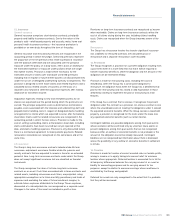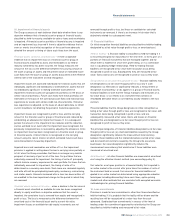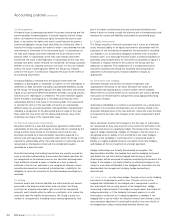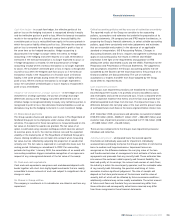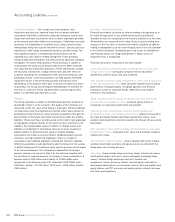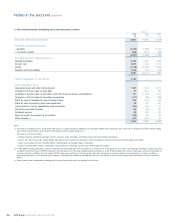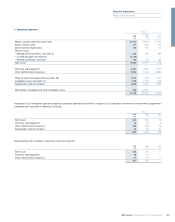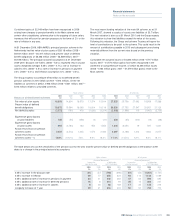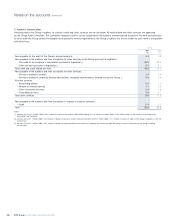RBS 2009 Annual Report Download - page 260
Download and view the complete annual report
Please find page 260 of the 2009 RBS annual report below. You can navigate through the pages in the report by either clicking on the pages listed below, or by using the keyword search tool below to find specific information within the annual report.Accounting policies continued
RBS Group Annual Report and Accounts 2009258
Accounting developments
International Financial Reporting Standards
The International Accounting Standards Board (IASB) published a
revised IFRS 3 ‘Business Combinations’ and related revisions to IAS 27
‘Consolidated and Separate Financial Statements’ following the
completion in January 2008 of its project on the acquisition and
disposal of subsidiaries. The standards improve convergence with US
GAAP and provide new guidance on accounting for changes in interests
in subsidiaries. The cost of an acquisition will comprise only
consideration paid to vendors for equity; other costs will be expensed
immediately. Groups will only account for goodwill on acquisition of a
subsidiary; subsequent changes in interest will be recognised in equity
and only on a loss of control will there be a profit or loss on disposal to
be recognised in income. The changes are effective for accounting
periods beginning on or after 1 July 2009 but both standards may be
adopted together for accounting periods beginning on or after 1 July
2007. These changes will affect the Group’s accounting for future
acquisitions and disposals of subsidiaries.
The IASB issued amendments to a number of standards in April 2009
as part of its annual improvements project. The amendments are
effective for annual periods beginning on or after 1 July 2009 and are
not expected to have a material effect on the Group or the company.
The IASB issued an amendment, ‘Group Cash-settled Share-based
Payment Transactions‘, to IFRS 2 ‘Share-based Payment’ in June 2009
that will change the accounting for share awards by permitting
accounting for equity settlement only by entities that either grant awards
over their own equity or have no obligation to settle a share-based
payment transaction. The amendment is effective for annual periods
beginning on or after 1 January 2010 and is not expected to have a
material effect on the Group or the company.
The IASB published an amendment ‘Classification of Rights Issues’ to
IAS 32 ‘Financial Instruments: Presentation’ and consequential revisions
to other standards in October 2009 to improve the accounting for issues
of equity for consideration fixed other than in the reporting entity’s
functional currency. The amendment is effective for annual periods
beginning on or after 1 February 2010 but it may be adopted earlier. It is
not expected to have a material affect on the Group or the company.
The IASB reissued IAS 24, ‘Related Party Disclosures’, in November
2009 clarifying the existing standard and to provide certain exemptions
for entities under government control. The revised standard is effective
for annual periods beginning on or after 1 January 2011.
The IASB issued IFRS 9 ‘Financial Instruments’ in November 2009
simplifying the classification and measurement requirements in IAS 39
‘Financial Instruments: Recognition and Measurement’ in respect of
financial assets. The standard reduces the measurement categories for
financial assets to two: fair value and amortised cost. A financial asset
is classified on the basis of the entity’s business model for managing
the financial asset and the contractual cash flow characteristics of the
financial asset. Only assets with contractual terms that give rise to cash
flows on specified dates that are solely payments of principal and
interest on the principal amount outstanding and which are held within a
business model whose objective is to hold assets in order to collect
contractual cash flows are classified as amortised cost. All other
financial assets are measured at fair value. Changes in the value of
financial assets measured at fair value are generally taken to profit or
loss. The standard is effective for annual periods beginning on or after 1
January 2013; early application is permitted.
This standard makes major changes to the framework for the
classification and measurement of financial assets and will have a
significant effect on the Group’s financial statements. The Group is
assessing this impact which is likely to depend on the outcome of the
other phases of IASB’s IAS 39 replacement project.
The International Financial Reporting Interpretations Committee (IFRIC)
issued interpretation IFRIC 17 ‘Distributions of Non-Cash Assets to
Owners’ and the IASB made consequential amendments to IFRS 5 ‘Non-
Current Assets Held for Sale and Discontinued Operations’ in December
2008. The interpretation requires distributions to be presented at fair
value with any surplus or deficit recognised in income. The amendment
to IFRS 5 extends the definition of disposal groups and discontinued
operations to disposals by way of distribution. The interpretation is
effective for annual periods beginning on or after 1 July 2009, to be
adopted at the same time as IFRS 3 ‘Business Combinations’ (revised
2008), and is not expected to have a material effect on the company.
The interpretation may affect the accounting treatment in the Group's
financial statements of the ABN AMRO businesses to be acquired by
the State of Netherlands following the reorganisation of ABN AMRO
Bank N.V. described in Note 16.
The IFRIC issued interpretation IFRIC 18 ‘Transfers of Assets from
Customers’ in January 2009. The interpretation addresses the
accounting by suppliers for assets received from customers, requiring
such assets to be measured at fair value. The interpretation is effective
for assets from customers received on or after 1 July 2009 and is not
expected to have a material effect on the Group or the company.
The IFRIC issued interpretation IFRIC 19 ‘Extinguishing Financial
Liabilities with Equity Instruments’ in December 2009. The interpretation
clarifies that the profit or loss on extinguishing liabilities by issuing equity
instruments should be measured by reference to fair value, preferably of
the equity instruments. The interpretation, effective for the Group for
annual periods beginning on or after 1 January 2011, is not expected to
have a material effect on the Group or the company.





